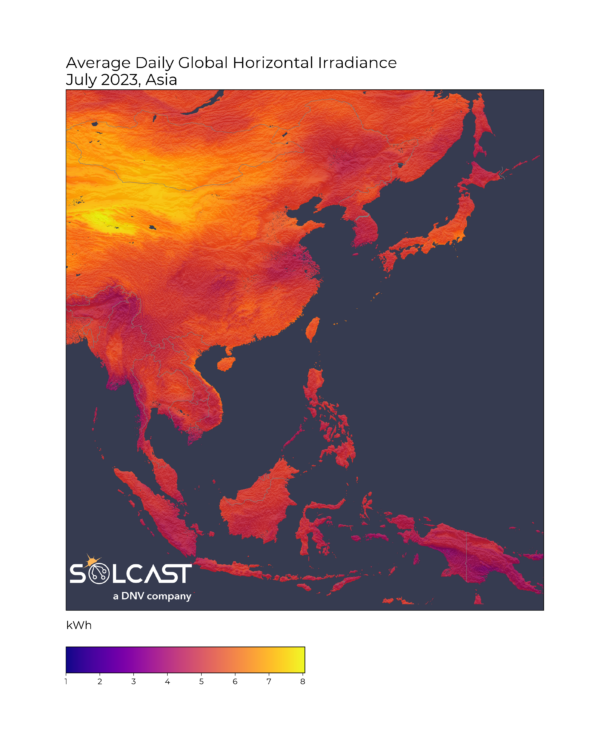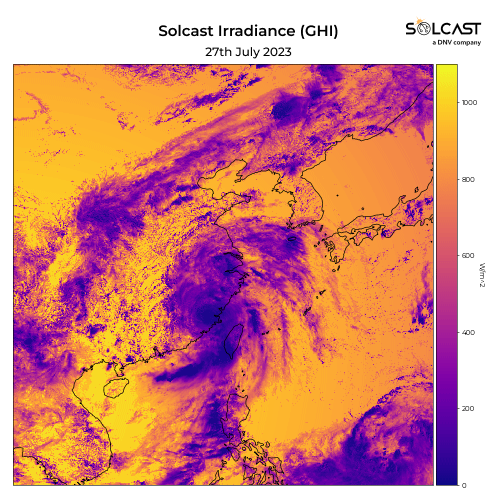July 2023 was a remarkable month in terms of weather activity worldwide, and Asia was no exception. After a sunny start to the month, Super Typhoon Doksuri and the associated cloudiness could not bring monthly irradiance below the long term averages for most of the continent, according to data collected by Solcast, a DNV company, via the Solcast API.

In a normal July, regions from Bangladesh to Indonesia see seasonal rains from the monsoon. However, this year, the rain and associated cloud were mostly concentrated further south. This led to up to 20% higher irradiance than normal in Bangladesh, and up to 10% higher than normal through Northern Thailand and Vietnam. The relatively high levels of solar capacity in Vietnam and Thailand will have benefited from this increased irradiance.
Japan
A dominant high-pressure weather system formed off Japan's east coast, which resulted in winds blowing from the west across the country. When these winds crossed Japan's mountain ranges, they lost moisture, resulting in clearer skies, especially towards the east. For irradiance, this meant a significant boost, up to 20% in some areas surrounding Tokyo compared to the usual for July.
North Eastern China
While Japanese solar production benefited from this system, North Eastern China faced the cloudier side of it. Increased rainfall and the after-effects of Super Typhoon Doksuri meant a slightly cloudier July than average. It's noteworthy that this area was the only region in Asia to see less-than-average irradiance this month.

Super Typhoon Doksuri's shadow
As well as the damaging effects of the storms, typhoons like Super Typhoon Doksuri dominate the regional cloud effects, which can limit solar energy generation. As the below visualization shows, the footprint was significant and drove cloud up the Chinese coast. While as this storm made landfall over Taiwan and parts of mainland China near the end of July, the month had already seen so much irradiance until then that the overall monthly total GHI remained consistent with or even higher than average, other than in North Eastern China.

Solcast produces these figures by tracking clouds and aerosols at 1-2km resolution globally, using satellite data and proprietary AI/ML algorithms. This data is used to drive irradiance models, enabling Solcast to calculate irradiance at high resolution, with typical bias of less than 2%, and also cloud-tracking forecasts. This data is used by more than 300 companies managing over 150GW of solar assets globally.
The views and opinions expressed in this article are the author’s own, and do not necessarily reflect those held by pv magazine.
This content is protected by copyright and may not be reused. If you want to cooperate with us and would like to reuse some of our content, please contact: editors@pv-magazine.com.



By submitting this form you agree to pv magazine using your data for the purposes of publishing your comment.
Your personal data will only be disclosed or otherwise transmitted to third parties for the purposes of spam filtering or if this is necessary for technical maintenance of the website. Any other transfer to third parties will not take place unless this is justified on the basis of applicable data protection regulations or if pv magazine is legally obliged to do so.
You may revoke this consent at any time with effect for the future, in which case your personal data will be deleted immediately. Otherwise, your data will be deleted if pv magazine has processed your request or the purpose of data storage is fulfilled.
Further information on data privacy can be found in our Data Protection Policy.